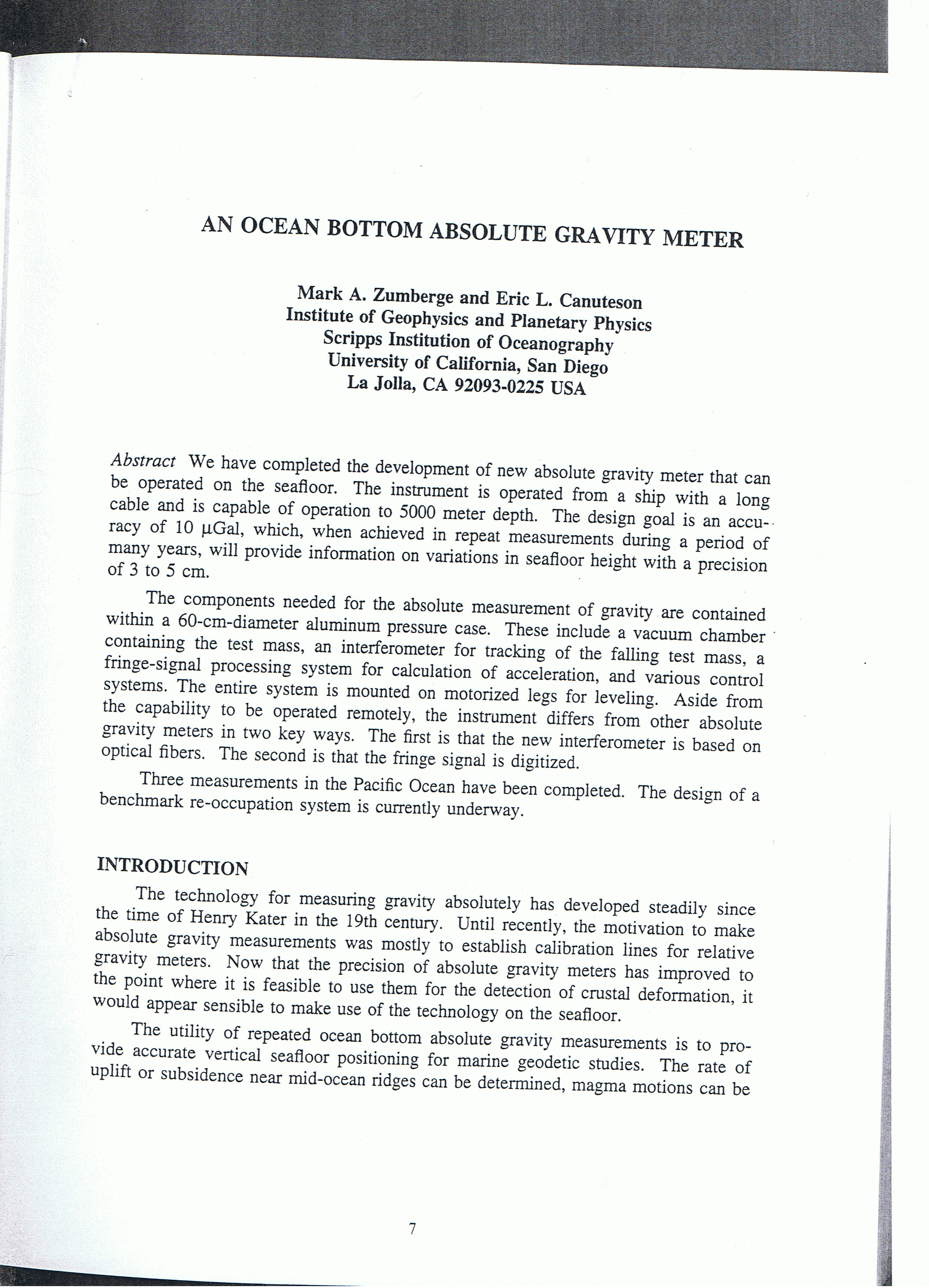CCF20100310�004

AN OCEAN BOTTOM ABSOLUTE GRAYITY METER
Mark A. Zumberge and Erie L. Canuteson Institute of Geophysics and Planetary Physics Scripps Institution of Oceanography University of California, San Diego La Jolla, CA 92093-0225 USA
Abstract We have completed the development of new absolute gravity meter that can be operated on the seafloor. The instrument is operated from a ship with a long cable and is capable of operation to 5000 meter depth. The design goal is an accu--racy of 10 (iGal, which, when achieved in repeat measurements during a period of many years, will provide information on variations in seafloor height with a precision of 3 to 5 cm.
The components needed for the absolute measurement of gravity are contained within a 60-cm-diameter aluminum pressure case. These include a vacuum chamber containing the test mass, an interferometer for tracking of the falling test mass, a fringe-signal processing system for calculation of acceleration, and various control systems. The entire system is mounted on motorized legs for leveling. Aside from the capability to be operated remotely, the instrument differs from other absolute gravity meters in two key ways. The first is that the new interferometer is based on optical fibers. The second is that the fringe signal is digitized.
Three measurements in the Pacific Ocean have been completed. The design of a benchmark re-occupation system is currently underway.
INTRODUCTION
The technology for measuring gravity absolutely has developed steadily sińce the time of Henry Kater in the 19th century. Until recently, the motivation to make absolute gravity measurements was mostly to establish calibration lines for relative gravity meters. No w that the precision of absolute gravity meters has improved to the point where it is feasible to use them for the detection of crustal deformation, it would appear sensible to make use of the technology on the seafloor.
The utility of repeated ocean bottom absolute gravity measurements is to pro-vide accurate vertical seafloor positioning for marinę geodetic studies. The ratę of uplift or subsidence near mid-ocean ridges can be determined, magma motions can be
7
Wyszukiwarka
Podobne podstrony:
CCF20120115�008 AN/AMZA KONSTRUKCJI (WMlAROMANlE) - S&K ,* S&U T źmsady przygotowania obci^h
CCF20121215�27 (5) 194 Jednostki bezwzględne (absolutne): • in - cal (lin = 2.54 cm) • cm -
CCF20140112�000 An American Resume Objective RESUME Johanneke Marie VAN DALE (Janneke) Breestraat
CCF20141029�005 An i (R 4 /f <2 C > c x c > CP <2
CCF20101124�000 (2) /my biuiuwi, Styl potoczny L a k o f f Gcorge, Johnson Mark, 1988, Metafory w na
18 John 1 12and13 ii£?ć?np£u- (kaxu4& an/Ł i_ę om, ^ iUĘWl V To them He gave the^ight to become
htdctmw 015 THE SECHETS OF- FORM! MAKING AN OBJECT LOOK REAL. Anyone, even you or I, can draw some s
Front AN EXORCIST WITH ATTITUDF. MORGAN KINGSLEY IS SURF. TO WIN BUCK A LEGION OF FANS."-Kclky
table dmhxgn8qvr1gwdt John Shark. Weil Sir Robert Mark said and 1 ąuoie /reads] The cancer oj corrup
CCF20110611�060 _ Percentile: A point (a grade or score) in a distribution below which falls the per
1933League of Nałions — Treaty Series. 1 Translation. No. 3210. — CONVENTION BETWEEN DEN MARK, NORWA
CCF20101207�003 48 zurę stanowi 1957 r., kiedy to przeprowadzono — przy udziale „Cranfield Institute
więcej podobnych podstron